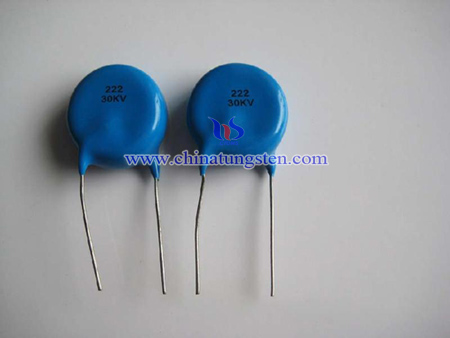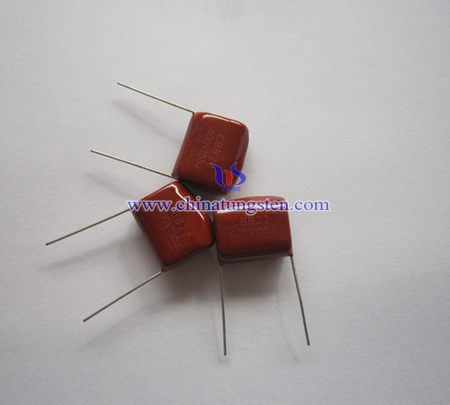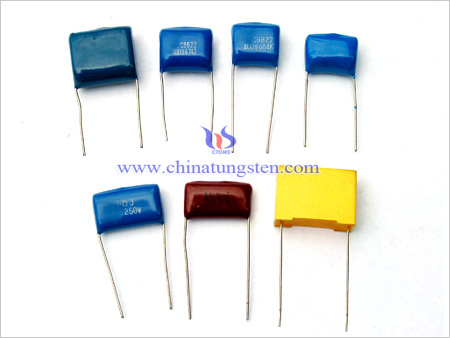Tungsten Powder and Tungsten Capacitor Element
- Details
- Category: Tungsten Information
- Published on Thursday, 07 July 2016 17:15
With the progress of small-size, high-speed and lightweight electronic devices such as cellular phones and personal computers, the capacitor used for these electronic devices is demanded to be smaller in size and lighter in weight and to have a larger capacitance and a lower equivalent series resistance (ESR).
As an example of such a capacitor, an electrolytic capacitor has been proposed, which capacitor is produced by anodically oxidizing a sintered body (anode body) obtained by sintering valve-acting metal powder such as tantalum which can be anodized to form a dielectric layer made of the oxide of the metal on the surface of the sintered body.
The electrolytic capacitor using tungsten as a valve-acting metal and employing a sintered body of the tungsten powder as an anode body can attain a larger capacitance compared to the electrolytic capacitor obtained with the same formation voltage by employing an anode body of the same volume using the tantalum powder having the same particle diameter.
The present invention proposed a tungsten powder comprising tungsten silicide in the particle surface region and having a silicon content of 0.05 to 7 mass %; an anode body comprising the sintered body of the tungsten powder; an electrolytic capacitor; and a production method thereof.

Problems to be Solved by the Invention
A tungsten capacitor element, which is obtained by forming a dielectric layer on the surface layer of an anode body obtained by sintering tungsten powder or a molded body thereof, and forming a semiconductor layer and a conductor layer in this order on a dielectric layer, is expected to be commercialized because the unit material cost of an anode body is low and the element has a large capacitance per volume. However, there are issues to contend with, including increase in LC after subjecting the capacitor element to heat treatment at a high temperature, for example, in a sealing process and in the treatment in a reflow furnace.
Accordingly, an object of the present invention is to provide a method for producing a high heat-resistance tungsten capacitor element.
Means to Solve the Problem
1. Detachment of a Semiconductor Layer in the Post-Chemical Formation Process
In the post-chemical formation process to repair defects generated on the dielectric layer, a part of the semiconductor layer is detached due to the ion migration and a thinned-out portion appears in the semiconductor layer. Along with this change, it is assumed that the thermal stress to the dielectric layer increases at the time of a high-temperature heat treatment, which results in the increase in leakage current.
Furthermore, the dielectric layer of a tungsten capacitor element is more susceptible to the reduction action and solvent action compared to that of a tantalum or niobium capacitor element due to the hydrogen and water as being a by-product at the time of forming a semiconductor layer. Accordingly, a post-chemical formation under more strict conditions is required and it is assumed that the detachment of the semiconductor layer is likely to occur and is susceptible to the increase in leakage current.
2. Residual of Unreacted Monomer and Low-Polymerization Oligomer in the Semiconductor Layer
After the process of forming a semiconductor layer, an unreacted polymer and a low-polymerization oligomer form a CT complex with a conductive polymer which constitutes the semiconductor layer, and attach to and remain in the semiconductor layer. Some of the residuals cannot be removed by the washing with a solvent. Accordingly, heat polymerization of the residual occurs when a capacitor element is subjected to a high-temperature heat treatment, and hydrogen and water (in a state of steam at a high temperature) are generated. The present inventors have thought that this causes the degradation of the dielectric layer and increase in leakage current.
As mentioned above, the dielectric layer of a tungsten capacitor element is susceptible to the action of hydrogen and water. Therefore, it is assumed that the dielectric layer is more likely to be affected by this factor.

The present invention relates to a production method of a capacitor element in the following [1] to [3].
[1] A method for producing a capacitor element, comprising:
a sintering process to form an anode body by sintering tungsten powder or a molded body thereof,
a chemical formation process to form a dielectric layer on the surface layer of the anode body,
a process of forming a semiconductor layer to form a semiconductor layer on the dielectric layer,
a post-chemical formation process to repair defects generated on the dielectric layer,
a non-aqueous electrolysis process to conduct an electrolysis operation by immersing the anode body in a non-aqueous solvent containing an oxidizing agent, and
a process of forming a conductor layer to form a conductor layer on the anode body, in this order.
[2] The method for producing a capacitor element as described in [1] above, wherein the oxidizing agent in the non-aqueous electrolysis process is at least one member selected from a group consisting of sulfonic acid, salt of sulfonic acid and organic peroxide.
[3] The method for producing a capacitor element as described in [2] above, wherein the oxidizing agent in the non-aqueous electrolysis process is naphthalenesulfonic acid or naphthalene sulfonate.
[4] The method for producing a capacitor element as described in [1] above, wherein the non-aqueous solvent in the non-aqueous electrolysis process is at least one member selected from a group consisting of methyl alcohol, ethanol, propyl alcohol, ethylene glycol and propylene glycol.
[5] The method for producing a capacitor element as described in [4] above, wherein the non-aqueous solvent in the non-aqueous electrolysis process is a mixed solvent of monovalent alcohol selected from a group consisting of methyl alcohol, ethanol, and propyl alcohol, and bivalent alcohol selected from a group consisting of ethylene glycol and propylene glycol.
Effect of the Invention
The method of the present invention enables the production of a high heat-resistance tungsten capacitor element, and particularly, a tungsten capacitor element in which leakage current (LC) does not increase after subjecting the capacitor element to heat treatment at a high temperature, for example, in a sealing process and in the treatment in a reflow furnace.

| Tungsten Powder Supplier: Chinatungsten Online tungsten-powder.com | Tel.: 86 592 5129696; Fax: 86 592 5129797;Email:sales@chinatungsten.com |
| Tungsten News & Prices, 3G Version: http://3g.chinatungsten.com | Molybdenum News & Molybdenum Price: http://news.molybdenum.com.cn |



 sales@chinatungsten.com
sales@chinatungsten.com